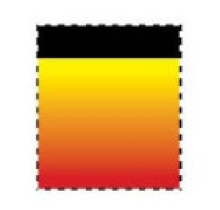“Whether the Forney Court got the analysis right may ultimately be answered by the Supreme Court, but in the meantime, applicants may seek to register at least multi-color product packaging marks at the USPTO by arguing that they are inherently distinctive.”
 Trademarks consisting solely of a color applied to products or their packaging have been protectable under U.S. law for decades—if they meet a heightened standard for protection. Since the U.S. Supreme Court decisions in Qualitex Co. v. Jacobson Products Co. and Wal-Mart Stores, Inc. v. Samara Brothers, Inc., an applicant for a color mark has been required to prove that the color actually serves as an indicator of source in the minds of consumers by showing that the mark has acquired distinctiveness (otherwise known as secondary meaning). Yet that longstanding requirement no longer applies to all color marks, after a new decision by the Federal Circuit in In re Forney, which opens the door for the first time to certain color marks gaining protection as inherently distinctive.
Trademarks consisting solely of a color applied to products or their packaging have been protectable under U.S. law for decades—if they meet a heightened standard for protection. Since the U.S. Supreme Court decisions in Qualitex Co. v. Jacobson Products Co. and Wal-Mart Stores, Inc. v. Samara Brothers, Inc., an applicant for a color mark has been required to prove that the color actually serves as an indicator of source in the minds of consumers by showing that the mark has acquired distinctiveness (otherwise known as secondary meaning). Yet that longstanding requirement no longer applies to all color marks, after a new decision by the Federal Circuit in In re Forney, which opens the door for the first time to certain color marks gaining protection as inherently distinctive.
Many famous single-color marks for products or their packaging have been registered after proof of acquired distinctiveness—Tiffany & Co.’s robin’s egg blue box, UPS’s brown delivery truck, 3M’s canary yellow Post-It and Cadbury’s purple candy wrapper, to name just a few. Before they could secure the registrations, these companies first had to cultivate consumer recognition of the particular color as an identifier of source: they advertised and promoted the color as their trademark, and sold products and services bearing that color for a substantial period of time, such that the color acquired distinctiveness. And then they had to convince an examiner at the U.S. Patent and Trademark Office (USPTO) that their color mark had actually acquired distinctiveness in the minds of consumers and was not functional—which is not an easy task, as General Mills learned in a recent, unsuccessful attempt to trademark the yellow box long used for CHEERIOS cereal.
A New Standard
But is all of this work to cultivate consumer recognition of a color mark always needed for a color mark to be a source identifier? The Forney decision signals a new, less burdensome standard for applicants of a very specific kind of color mark: namely, multi-color marks used on product packaging. In Re Forney Indus., Inc., No. 2019-1073 (Fed. Cir. Apr. 8, 2020). The Federal Circuit held that this specific class of color marks could be inherently distinctive and therefore registrable without proof of acquired distinctiveness.
Inherently distinctive trademarks are “designations that are so distinctive in and of themselves that they are irrefutably presumed to have achieved customer recognition as a[] symbol of origin immediately upon first use as a mark.” J. Thomas McCarthy, McCarthy on Trademarks and Unfair Competition § 16:3 (5th ed. 2020). Historically, word and image marks were the only kinds of marks that courts considered inherently distinctive—like the coined term Xerox or the stylized Apple logo on an iPhone. Forney provides, for the first time, that a type of color mark may also be inherently distinctive.
Case Background
Forney Industries, Inc. sells accessories and tools for welding and machining and uses product packaging in different shapes and sizes that bear a specific yellow-to-red gradient below a black rectangle, as shown below and on the specimens Forney submitted in connection with its trademark application:

In 2014, Forney applied to register this mark on the Principal Register, which is reserved for marks that are either inherently distinctive or have acquired distinctiveness. In applying for registration on the Principal Register, Forney did not provide evidence that its color mark had acquired distinctiveness and instead, merely relied on a theory of inherent distinctiveness. The examining attorney at the USPTO found that color marks could never be inherently distinctive and denied Forney’s application to the Principal Register.
Forney appealed the examining attorney’s decision to the Trademark Trial and Appeal Board (TTAB), arguing that its mark was inherently distinctive because it was sufficiently unique and consisted of multiple colors applied to product packaging, not product design. Forney argued that, under the Supreme Court’s holding in Wal-Mart, only color marks applied directly to a product’s design can never be inherently distinctive.
The TTAB affirmed the examining attorney’s decision, holding that, while certain product packaging can be inherently distinctive, color marks—whether applied to product packaging or to product design—cannot be as a matter of law. In re Forney Indus., Inc., 2018 WL 4348337, *5 (T.T.A.B. Sept. 10, 2019). The TTAB further held that a color mark cannot be inherently distinctive unless it is used in association with a peripheral shape or border. Id. at 6.
The Federal Circuit’s Decision
Forney appealed the TTAB’s ruling to the Federal Circuit, which reversed. The Federal Circuit reasoned that the U.S. Supreme Court has never held that color as applied to product packaging must acquire distinctiveness to be registrable. In the absence of Supreme Court precedent, the court found as a matter of first impression that although color is usually ornamentation, “a distinct color-based product packaging mark” could serve as a source identifier and could be inherently distinctive.
In reaching this holding, the Federal Circuit waded through several Supreme Court opinions on trade dress, consistently offering narrow readings of each. This meant reconciling a number of prominent trade dress cases: Two Pesos, Inc. v. Taco Cabana, Inc., 505 U.S. 763 (1992), in which the Supreme Court held that trade dress can be inherently distinctive and protectable without secondary meaning; Qualitex Co. v. Jacobson Prod. Co., 514 U.S. 159, 163 (1995), in which the Supreme Court declined to “find . . . any obvious theoretical objection to the use of color alone as a trademark, where that color has attained secondary meaning”; and Wal-Mart Stores, Inc. v. Samara Brothers, Inc., 529 U.S. 205, 212 (2000), in which the Supreme Court, considering a product design trade dress, explained that “design, like color, is not inherently distinctive.”
The Forney panel’s course was by no means the only reading of these precedents. Indeed, many of them reference color in general as lacking inherent distinctiveness. Forney’s discussion of Qualitex—the only Supreme Court case dealing directly with the protectability of a color mark—does not provide much clarity. There are two key differences between Qualitex and Forney:
(1) Qualitex involved a product design trade dress for dry-cleaning pads, whereas Forney involved a product packaging trade dress for accessories and tools for welding and machining.
(2) Qualitex involved a green single-color mark, whereas Forney involved a red, orange, and yellow multi-color mark.
Rather than analyze the importance of each of these key differences using the Qualitex opinion as a guide, the Federal Circuit simply said that these differences mean that Qualitex does not control the analysis for multi-color product packaging marks, and noted that Two Pesos held generally that that product packaging can be inherently distinctive. The Forney opinion went on to note that Wal-Mart characterized Qualitex as holding that color can never be inherently distinctive. Forney suggested, however, that this characterization applies only to product design, because that’s what Wal-Mart was about—in that case, the design of children’s clothing. But dicta from Wal-Mart suggests that the Court was thinking about color more generally: the Court explained that “with respect to at least one category of mark – colors – [it has] held that no mark can ever be inherently distinctive . . . However, [it] noted that, ‘over time, customers may come to treat a particular color on a product or its packaging . . . as signifying a brand.’” Wal-Mart Stores, Inc., 529 U.S. at 212 (emphasis added).
The Forney panel worked to distinguish the Wal-Mart language, and the Supreme Court’s jurisprudence more generally, by pointing to the other key distinction between Qualitex and Forney: use of a single-color mark (“a particular color,” as the Wal-Mart Court put it) and use of a multi-color mark like Forney’s. However, in its opinion, the Federal Circuit did not directly grapple with whether Supreme Court precedent applies equally to multi-color marks and single-color marks. Because the Supreme Court has only considered color marks directly in Qualitex, which involved a mark consisting of a single color, the Wal-Mart Court may have intended its reasoning similarly to apply only to single-color marks.
Implications
Whether the Forney Court got the analysis right may ultimately be answered by the Supreme Court, but in the meantime, applicants may seek to register at least multi-color product packaging marks at the USPTO by arguing that they are inherently distinctive. Of course, USPTO examiners (or the courts) have never before had to confront the question of what would make a color mark inherently distinctive, and the Forney opinion offered only the most generic guidance, pointing to the Federal Circuit’s holdings about inherent distinctiveness in the context of word and image marks.
Based on the Federal Circuit’s guidance in Forney, there are a few considerations for companies if they want to apply for a multi-color product packaging mark on the basis of inherent distinctiveness:
- Are the colors commonly used in the field, or are they unique and unusual? For example, Forney’s mark uses bright yellows, oranges, and reds, which are frequently used in the construction industry for visibility—though on product design, not necessarily packaging. Examiners, however, might not distinguish between the two when evaluating the commonality of colors.
- Are the colors merely a refinement of a well-known design for a particular class of goods? Here, for example, it would be difficult for a chain of barbershops to try to adopt a red, white, and blue striped product design and claim inherent distinctiveness, given the near-universal use of that design to signal a barbershop.
- Does the color create an impression distinct from any accompanying words? Forney’s trade dress is again interesting to consider under this prong. The black bar at the top of Forney’s design is used to set off the stylized word “Forney” on each product. An examiner might conclude that black bar is therefore part of the impression created by the FORNEY word mark, and does not create a distinct impression as trade dress—or, alternatively, might conclude the black bar helps create a border for the color mark that makes it distinctive.
Of course, it is possible the government will seek cert at the Supreme Court to get an answer to these questions before examiners are tasked with analyzing the inherent distinctiveness of color marks. Indeed, while the Forney opinion tries to argue that its reasoning is the same as that of a Tenth Circuit panel (which was considering the exact same Forney mark), the Tenth Circuit actually held that Forney’s multi-color mark was not registrable, and that multi-color marks on product packaging could be registered only without a showing of acquired distinctiveness if they were part of a well-defined shape, pattern or other distinctive design. Forney Indus., Inc. v. Daco of Missouri, Inc., 835 F.3d 1238 (10th Cir. 2016). The government may well be able to argue that there is a split between the circuits on this question and ask the Supreme Court to resolve the status of multi-color marks once and for all.

![[IPWatchdog Logo]](https://ipwatchdog.com/wp-content/themes/IPWatchdog%20-%202023/assets/images/temp/logo-small@2x.png)



![[Advertisement]](https://ipwatchdog.com/wp-content/uploads/2024/04/Artificial-Intelligence-2024-REPLAY-sidebar-700x500-corrected.jpg)
![[Advertisement]](https://ipwatchdog.com/wp-content/uploads/2024/04/UnitedLex-May-2-2024-sidebar-700x500-1.jpg)
![[Advertisement]](https://ipwatchdog.com/wp-content/uploads/2024/04/Patent-Litigation-Masters-2024-sidebar-700x500-1.jpg)

![[Advertisement]](https://ipwatchdog.com/wp-content/uploads/2021/12/WEBINAR-336-x-280-px.png)
![[Advertisement]](https://ipwatchdog.com/wp-content/uploads/2021/12/2021-Patent-Practice-on-Demand-recorded-Feb-2021-336-x-280.jpg)
![[Advertisement]](https://ipwatchdog.com/wp-content/uploads/2021/12/Ad-4-The-Invent-Patent-System™.png)






Join the Discussion
2 comments so far.
William W. Cochran
May 27, 2020 11:58 amI argued In re Forney at the Federal Circuit. I was also involved in the 10th Circuit case Forney Indus., Inc. v. Daco of Missouri, Inc., 835 F.3d 1238 (10th Cir. 2016). The Marks were not the same. The mark in Forney v. Daco was described by writing as is required in a 43(a) infringement action. That description was different from the drawing submitted in the In re Forney application. The holding in Forney v Dako was that the description was too vague and as such, was unenforceable. There was no holding in Forney v Dako that conflicted in any way with the holding in In re Forney. In fact, the 10th Circuit in Forney v Dako refers to the Restatement (third) of Unfair Competition which states that “color can be protected as a trademark when used as part of a design, pattern or combination of colors that as a whole is inherently distinctive or has acquired distinctiveness.” The Federal Circuit recognized that the In re Forney mark created a design or pattern with a combination of colors and remanded for consideration of the Seabrook tests.
William W Cochran
May 15, 2020 04:06 pmThis is a good analysis of In re Forney. However, the marks in In re Forney and Forney Indus., Inc. v. Daco of Missouri, Inc., 835 F.3d 1238 (10th Cir. 2016) were not the same. The mark in In re Forney was embodied in the drawing submitted with the application. The mark in Forney v Daco was a written description which differed from the In re Forney mark. The 10th Circuit held that the written description was unclear and not protected. I argued In re Forney and Chris Benson argued Forney v Daco.